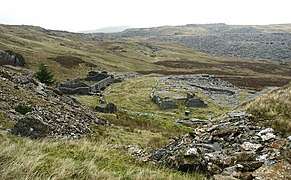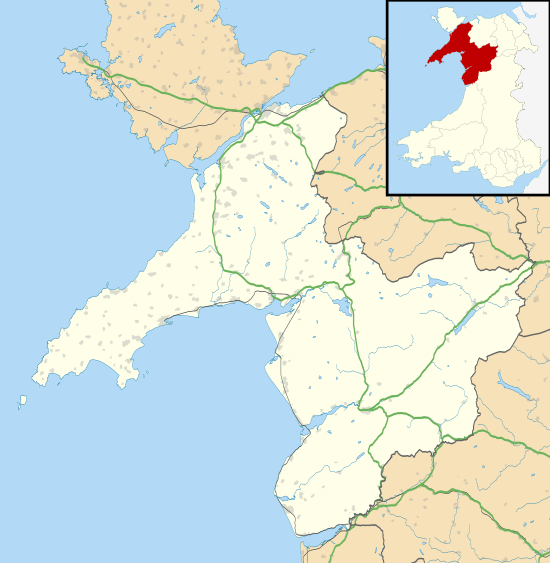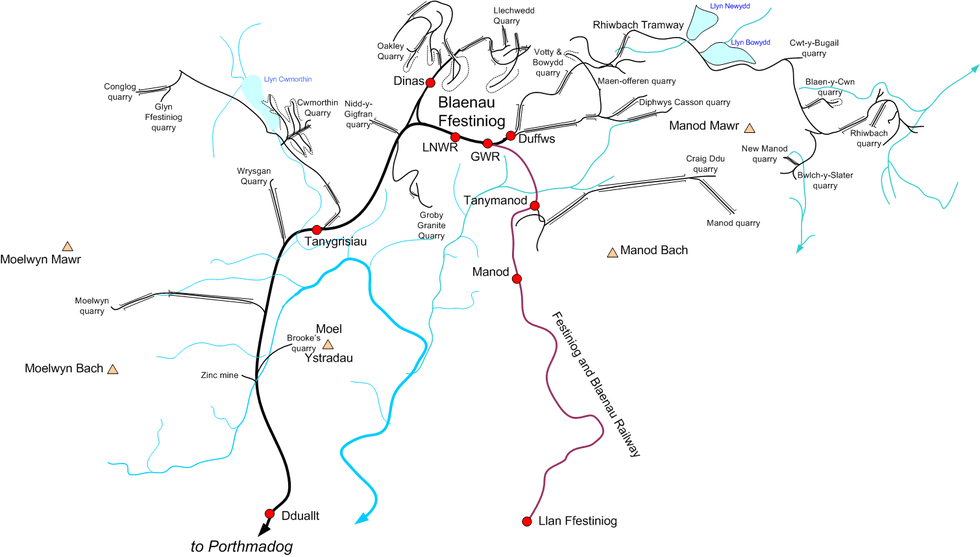Blaen y Cwm quarry
The Blaen y Cwm quarry was a slate quarry located east of Blaenau Ffestiniog in Wales. It was first worked in some time between 1813 and 1818 and sporadically after that until 1914. The quarry was connected to the Ffestiniog Railway at Duffws Station via the Rhiwbach Tramway.[1]
 The ruinous mill at Blaen y Cwm in 2005 | |
| Location | |
|---|---|
 Blaen y Cwm quarry Location in Gwynedd | |
| Location | near Blaenau Ffestiniog |
| County | Conwy County Borough |
| Country | Wales, UK |
| Coordinates | 52.9988°N 3.8884°W grid reference SH7328346310 |
| Production | |
| Products | Slate |
| Type | Quarry |
| History | |
| Opened | c.1813 |
| Closed | 1914 |

History
Blaen y Cwm and the nearby Cwt y Bugail quarry both sit on land that was owned until the 1860s by the Wynne family of Peniarth. The first indication of quarrying activity on the Blaen y Cwm site is a map from 1818 that shows a modest quarry here. These early workings continued for some years on a small scale.
In 1838 the quarry was leased for 21 years to Adam Gregory who also held the lease for Cwt y Bugail as well as a number of other Welsh mines and quarries. Gregory's operations were not a financial success and in 1849 he surrendered the lease to Blaen y Cwm.
In 1853, brothers Thomas and James Swinton Spooner of the Ffestiniog Railway leased Blaen y Cwm and worked it for two years. The Spooner family planned to extend the Ffestiniog Railway to the nearby Rhiwfachnoquarry, with branches to serve the local cluster of quarries at Blaen yt Cwm, Cwt y Bugail and Rhiwbach. Despite a bill being put before Parliament in 1854 this scheme was dropped and the lease for the quarry again was given up.
In 1861 a new lease for Blaen y Cwm was granted to Hugh Beaver Roberts of Bangor. This lease passed through several hands in a series of dubious transactions before settling with William Henry Gatty of Market Harborough. He began to work the quarry under the title the Blaenycwm Slate Company.
Production on a relatively small scale continued through the 1870s, but the quarry, now known as Pen-y-ffridd, was abandoned by 1888. In 1889 the quarry was purchased by E.P. Jones the manager of Diffwys quarry, who worked it that year and in 1890, but again slate extraction ceased from 1891 to 1897.
Another attempt to work Blaen y Cwm started in 1898 under the ownership of the new Blaenycwm Slate Quarry Co. Ltd. This lasted until 1903, but was voluntarily wound up.
The final attempt to make a success of the quarry began in 1904 with a new company. This worked on a limited scale until 1906, followed by a hiatus until revived in 1910. The quarry finally closed on 8 May 1914. Apart from some surface extraction of "rustic slates" by a local man in the 1960s, Blaen y Cwm did not operate again.
Transport
Until about 1820 the output of Blaen y Cwm was shipped by packhorse to Conwy via the Cwm Machno and Conwy Valley. From that date onwards, slate was shipped out, still on packhorse, over the mountain to Ffestiniog and on to Porthmadog.
From 1869 the quarry used the Rhiwbach Tramway to connect with the Ffestiniog Railway at Blaenau Ffestiniog. Until 1872 the slate was carried by hand or wheelbarrow uphill to the tramway. An incline was constructed in 1872 that allowed a less manually intensive direct connection between the internal quarry tramways and the Rhiwbach Tramway above. The incline was unusual in that the haulage engine was located at the bottom.
The internal quarry tramways were laid in very light rail suitable for hand working of single wagons. They were laid to a nominal 1 ft 11 1⁄2 in (597 mm) narrow gauge throughout, matching the gauge of the Rhiwbach Tramway. There is no evidence that locomotives were ever used within the quarry.
Geology
Description
References
- Lewis, M.J.T. (2003). Blaen y Cwm and Cwt y Bugail Slate Quarries. Adit Publications. ISBN 0952297930.